MARIANI’S
Virtual Gourmet
JUNE 23,
2019
NEWSLETTER
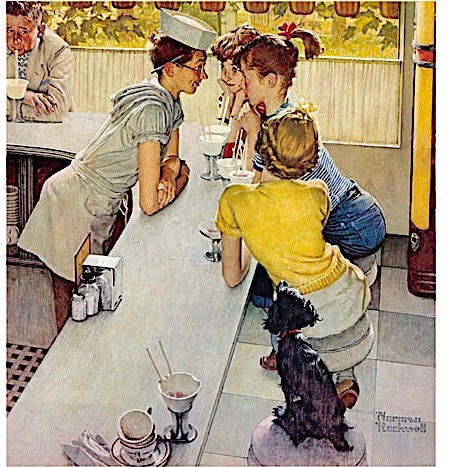
(Saturday Evening Post, August 22, 1953)
❖❖❖
IN THIS ISSUE
STAYING AND EATING AROUND VAUD
By John Mariani
NEW YORK CORNER
LEONTI
By John Mariani
CELEBRATE SUMMER'S ARRIVAL WITH
THESE WONDERFUL WITH THESE
By John Mariani
❖❖❖
STAYING AND EATING
IN VAUD, SWITZERLAND
By John Mariani
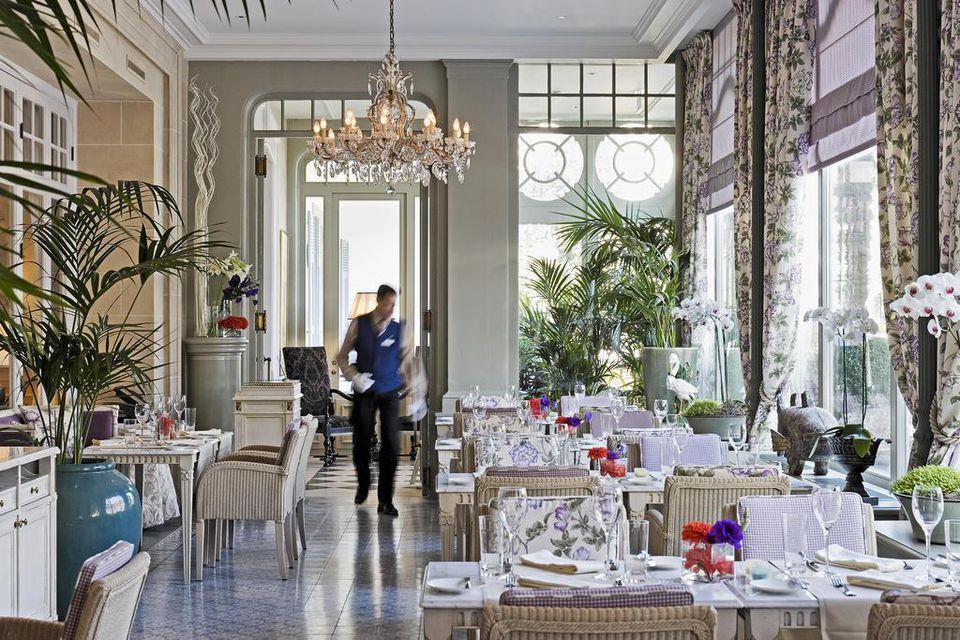
La Verandah Brasserie, Grand Hotel du Lac, Vevey
Lying within Switzerland’s French canton, Vaud quite naturally nods to Gallic tradition in its cuisine. Yet, most menus take advantage of Vaud’s own regional and seasonal provender, dairy, meat and seafood. Though this last depends largely on importation, Lake Leman/Geneva is abundant with trout, perch, fera and the wonderful omble chevalier, a char that lives in cold Alpine lakes.
The cheeses of Vaud are world famous, from tête de Moine (“monk’s head”) and raclette, melted on bread and used in fondues, to Gruyère and Emmenthaler.
Restaurants in cities like Vevey and Montreux proudly serve the traditional dishes along with bright innovations on French and Swiss cuisine. Here are three that give an idea of their range.
(By the way, in Swiss restaurants tips are not mandatory, though it is customary to leave between 3% and 5% of the bill. Also, the US$ is nearly at parity with the Swiss franc)
GRAND HOTEL DU LAC
Rue d’Italie 1
Vevey
+41 21 925 06 06
 In
the lakeside city of Vevey, my wife and I
checked into the appropriately named
Grand Hotel du Lac, which stretches out along
the lake in view of the Dents du
Midi Alps. A slow stroll along the Quai
Perdonnet is always as inspiriting as
it is breathtaking, not least when the passenger
boats sail slowly into view and
the swans scurry away.
In
the lakeside city of Vevey, my wife and I
checked into the appropriately named
Grand Hotel du Lac, which stretches out along
the lake in view of the Dents du
Midi Alps. A slow stroll along the Quai
Perdonnet is always as inspiriting as
it is breathtaking, not least when the passenger
boats sail slowly into view and
the swans scurry away. 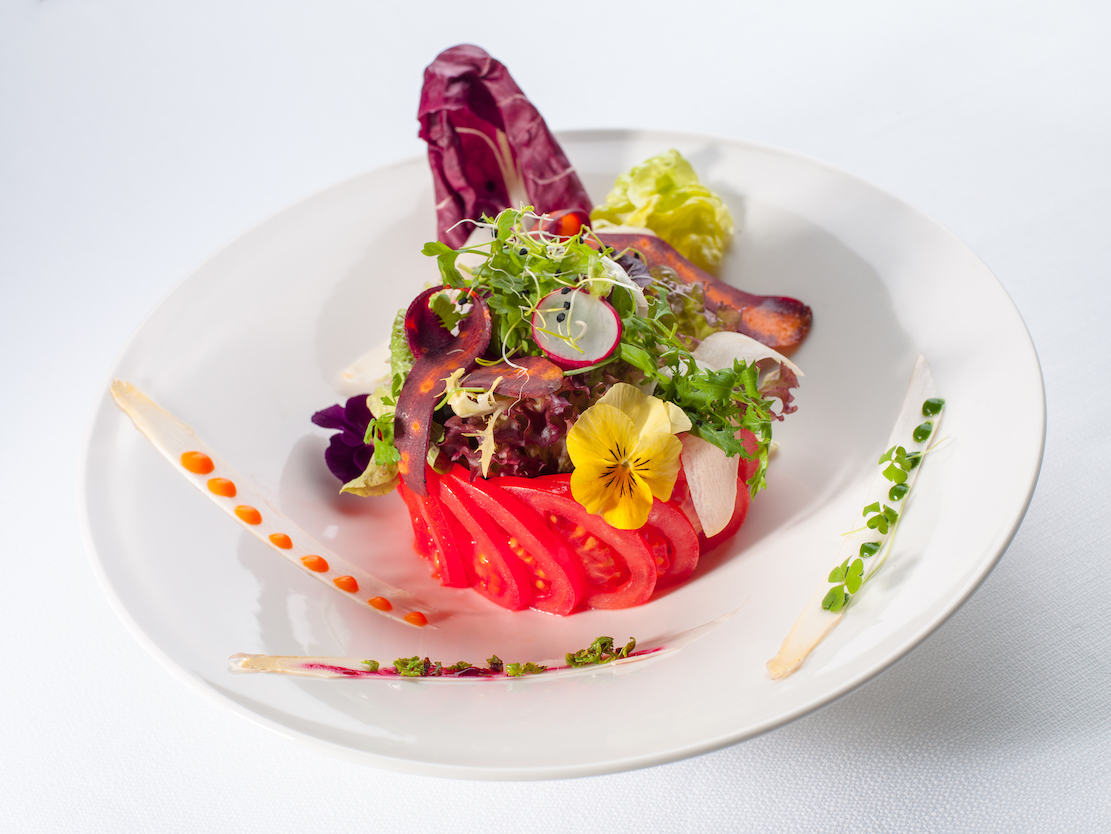
Built in 1868, the hotel has since hosted most of those personages who have come through Vaud, from young people on the Grand Tour and aristocracy in exile to artists seeking quiet and those seeking refuge in wartime. The heroine of Anita Brookner’s 1984 comic novel Hotel du Lac stays there after an indiscreet “lapse” in London in an effort to “grow up.” That plan does not work out so well, because the romantic cast of the hotel, with hallways of civilized length, crystal chandeliers, a broad terrace and flowery lawn, fountain and exquisite appointments throughout are as much a temptation to dalliance as anywhere in Europe.
In
need
of an extensive facelift, the 50-room hotel was
closed in 2005 and brought
into modern focus, admirably retaining all the
lineaments that make it such a
peaceful place, with all the modern amenities of
43-inch LED TV, free WiFi,
choice of pillows, marble bathrooms and Guerlain
products. The decorator was Pierre Yves-Rochon, who
did the Four Seasons Hotel George
V in Paris.
The
intimately chic bar done in Chinoiserie is snug
and soigné, and the 25-seat Les
Saisons restaurant, under chef Thomas Neeser, is
considered one of the finest
in Switzerland. When my wife and I stayed at the
hotel, Les Saisons was closed,
but we had the great pleasure of sampling Neeser’s
cuisine at La Veranda,
described as a brasserie—though
you’d never mistake it for one
of those large, fast-paced brasseries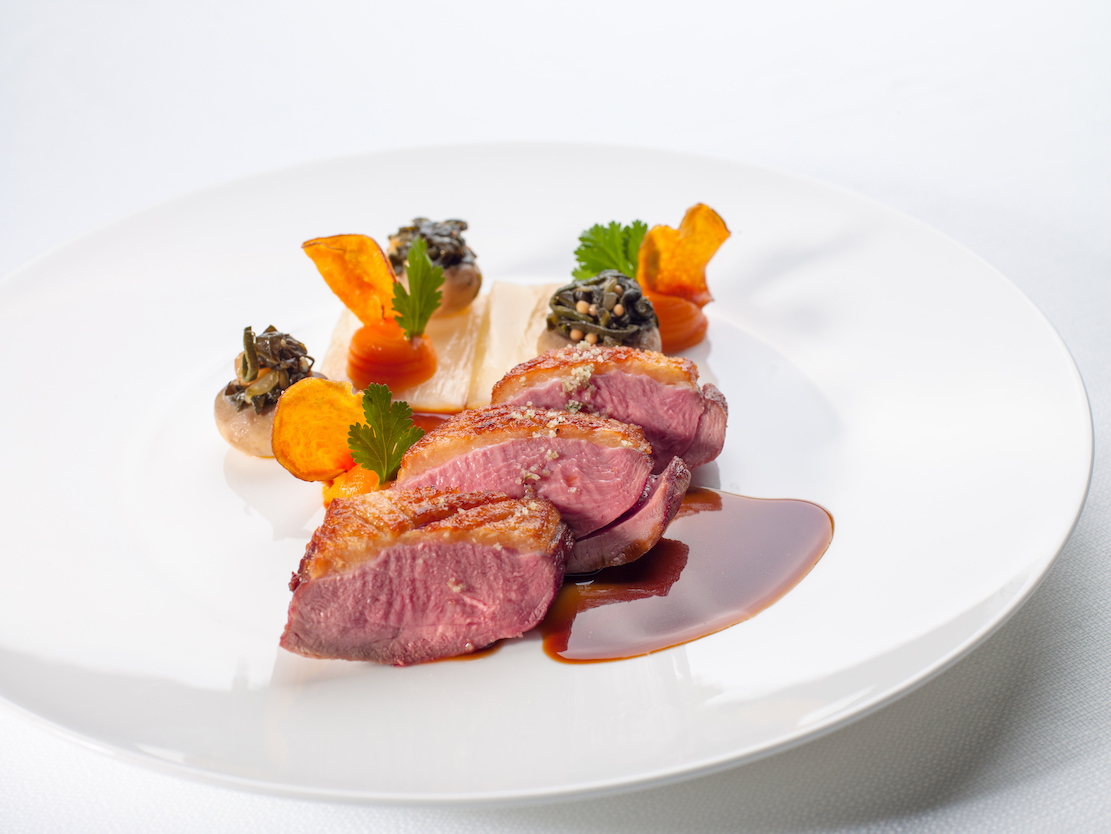 in Paris. La Veranda is all
sweetness and
light, which pours in from the tall windows and
heightens the pastel colors of
the beautifully decorated room.
in Paris. La Veranda is all
sweetness and
light, which pours in from the tall windows and
heightens the pastel colors of
the beautifully decorated room.
We
had Neeser choose our candlelit dinner—lunch runs
39CHF or 59CHF; dinner 85CHF,
which is remarkable for cuisine of this quality—
beginning with a salad of
candied leeks and a light truffled potato foam,
along with a sausage fritter
stuffed with cabbage. Our two
appetizers were a “lobster composition” with
celery, potatoes and black
truffles, and an “opéra” of
foie gras
touched with sweet limoncello liqueur, caramelized
turnips and toasted brioche.
Tender ravioli (above)
oozed rich 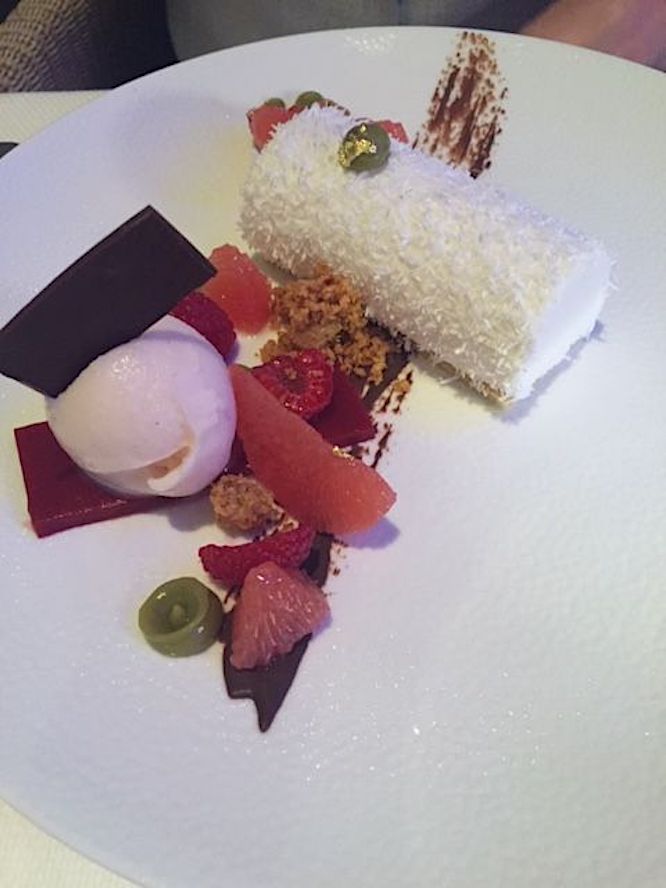 Vacherin
Mont-d'Or cheese with a truffled artichoke
cream, walnut and celery vinaigrette and fried
parsley. Perch fillets from the
lake—“according to arrival”—were bathed in a meunière butter with gnocchi and
toasted hazelnuts.
Vacherin
Mont-d'Or cheese with a truffled artichoke
cream, walnut and celery vinaigrette and fried
parsley. Perch fillets from the
lake—“according to arrival”—were bathed in a meunière butter with gnocchi and
toasted hazelnuts.
The meat course was Swiss beef tenderloin with its own silky marrow whose richness was cut by an assertive vinegar jus, with braised rutabaga puree, salsify and beet chips. For dessert there was a lovely hazelnut shortbread millefeuille and iced dark chocolate mousse with coffee cream, licorice and Clementine.
The dinner was so impeccably rendered that we couldn’t imagine how the food at Les Saisons could be any better. And at breakfast La Veranda is a room cheery enough to restore anyone who is lamenting leaving the Grand Hotel du Lac.
LES
TROIS SIFFLETS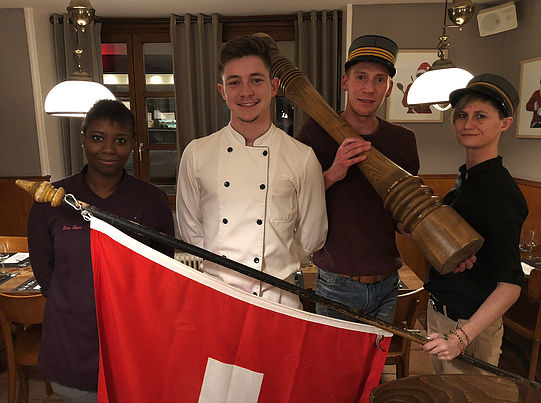
Rue du Simplon 1
Vevey
+41 21 921 14 13
Fondue
is easily the
most identifiable of Swiss dishes, especially
back when fondue pots and
utensils were all the rage as wedding gifts. For the real deal, plus
a thirty-second floor show and
fanfare, you must go to Les Trois Sifflets
(The Three Whistles), tucked away in
the curving streets of Vevey.
You’ll
spot its
red sign hanging outside and through the windows
you’ll see what you’re getting
into: within a cozy series of small rooms, there
is always a table of people
laughing, for
every few minutes,
there is the effusive presentation of the fondue
as the staff performs a little
routine of brandishing gigantic pepper mills
and
Swiss flags while the national
anthem plays to applause. It’s a gimmicky
ceremony well worth going along with
any time you crave a true fondue.
Despite
the cauldron of cheese to come, we began with a
fried cheese fritter called a malakoff (16CHF), whose name, for
some reason, commemorates the 1855 Battle of
Malakoff
during the siege of Sevastapol by Swiss
mercenaries.
We
dined with an
acquaintance who told us fondue is always
enjoyed with Swiss white wine, not
beer, because the acidity of a wine like
Chasselas helps cut the richness of
the cheese. The dunking of the bread into the
bubbling liquid is a great deal
of the communal fun, and the flavor is so good
that you might consider finding
that old wedding gift at home and putting it to
use.
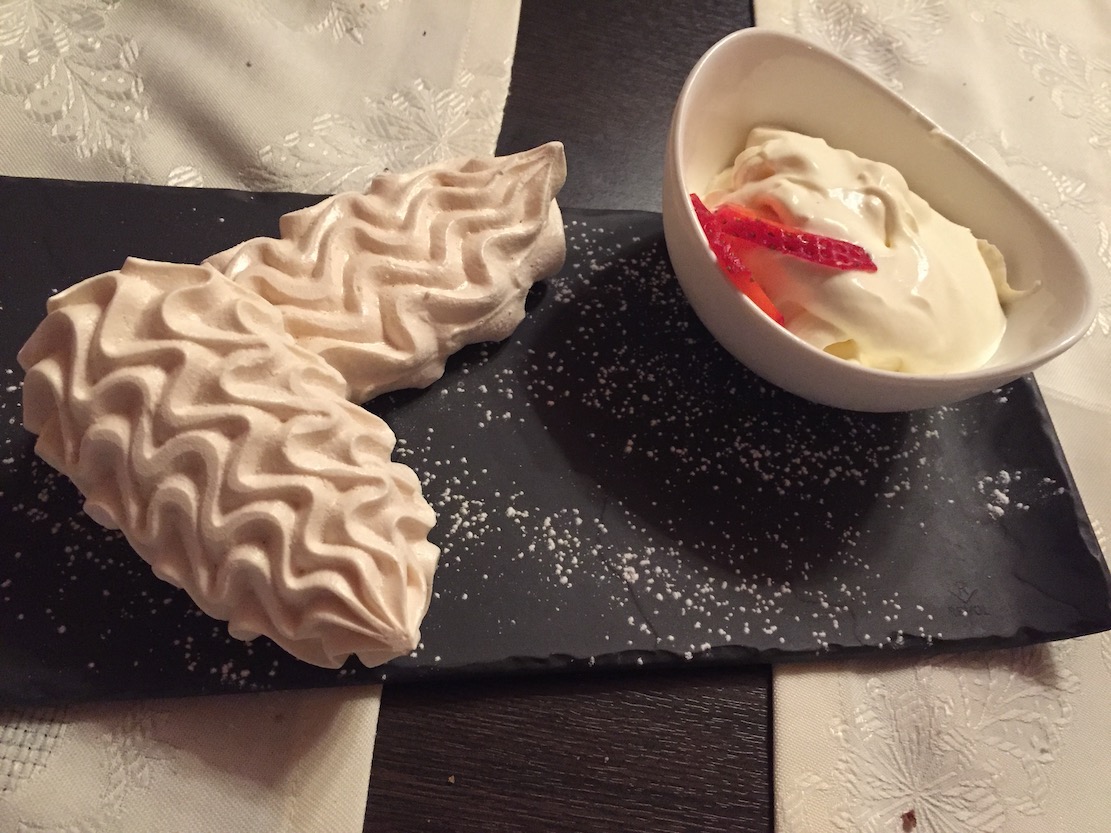 Another
dish new to me was papet
(28CHF), a large, fat sausage
stuffed with cabbage leeks, potatoes, cream and
white wine (right),
which by
tradition you are supposed to cut open, scrape
out the insides and discard the
skin. It was very heavy but quite delicious.
Another
dish new to me was papet
(28CHF), a large, fat sausage
stuffed with cabbage leeks, potatoes, cream and
white wine (right),
which by
tradition you are supposed to cut open, scrape
out the insides and discard the
skin. It was very heavy but quite delicious.
Dessert was
a tad lighter: a meringue in double
cream (10CHF).
The fondue
is 24CHF-27CHF per person. The menu also offers
fried fish with salad and French fries for 45CHF,
and a
plate of the day for 19CHF, trout meunière for 32CHF and other
dishes. Right now you’ll be able to dine
outside.
LE
PONT DE BRENT
Route de Blonay
Brent
+41 21 964 52 30
You’ll need a driver or a dependable GPS to find this charming chef-owned restaurant in the town of Brent, about 20 minutes from Vevey or 11 from Montreux. Once in the village you’ll find a trim little house with a welcoming front door that leads into two pale gray dining rooms, both minimal in décor, with widely separated tables and very fine table settings.
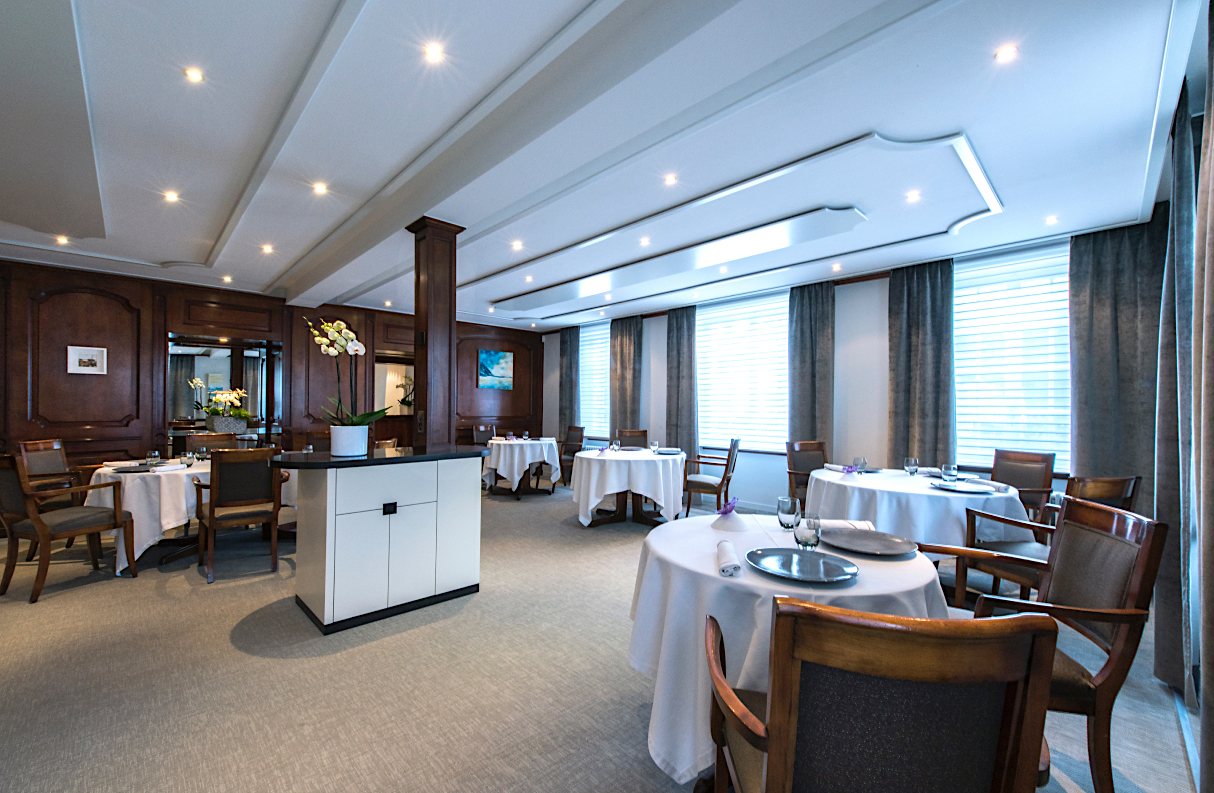 There, chef
Stéphane Décotterd, with his lovely
wife, Stéphanie (right),
has established himself as one the young masters
of modern
French-Swiss cuisine, with every dish clearly his
own. The restaurant opened in
1980 under Gérard
Rabaey, who handed over the apron
to Décotterd in 2011, making him swear to keep
the style and quality of haute
cuisine ever intact. Working with local farmers,
fishermen, foragers and
vignerons, Decotterd has certainly kept the
faith, and he revels in local
products.
There, chef
Stéphane Décotterd, with his lovely
wife, Stéphanie (right),
has established himself as one the young masters
of modern
French-Swiss cuisine, with every dish clearly his
own. The restaurant opened in
1980 under Gérard
Rabaey, who handed over the apron
to Décotterd in 2011, making him swear to keep
the style and quality of haute
cuisine ever intact. Working with local farmers,
fishermen, foragers and
vignerons, Decotterd has certainly kept the
faith, and he revels in local
products.
We
began our meal with a
bite of wafer with whipped Vacherin cheese and
little bon bons (below)
with honey
mustard and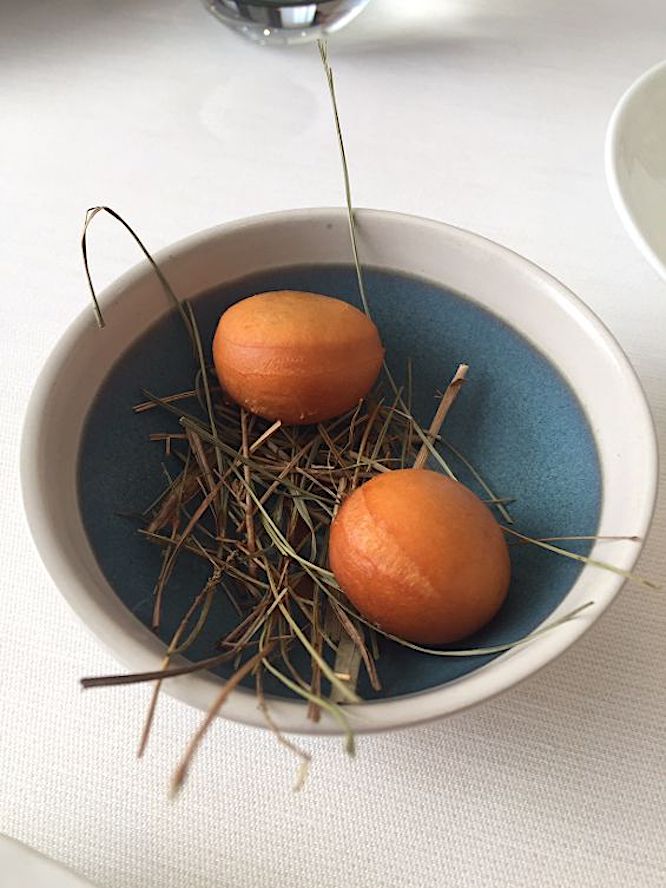 saffron.
Small ravioli of beef were dotted with Swiss
farmed
sturgeon caviar and a gelée of ginger and
cucumber, followed by a delightful omble chevalier
sausage in a deeply flavorful court-bouillon
flavored with
fennel and dill. Fried goujonettes
of
lotte were lavished with a shrimp sauce. All the
fish had that remarkable,
singular flavor of their species, which is a
rarity on this side of the
Atlantic when European fish are flown in.
saffron.
Small ravioli of beef were dotted with Swiss
farmed
sturgeon caviar and a gelée of ginger and
cucumber, followed by a delightful omble chevalier
sausage in a deeply flavorful court-bouillon
flavored with
fennel and dill. Fried goujonettes
of
lotte were lavished with a shrimp sauce. All the
fish had that remarkable,
singular flavor of their species, which is a
rarity on this side of the
Atlantic when European fish are flown in.
Next was a
salad of salsify
with a cheese puree and black truffles with
marvelous aroma. Dessert included
intense sorbets of the season, and wild
raspberries meringue and cream. Gelato was scented
with lemon verbena plucked from the garden (left), and
the modern version of
Black Forest chocolate cake with cherries was
lighter and more refined than most.
It
is always a joy to find a
couple married as much to their labor of love as
to themselves, and the
Décotterds work very, very hard to stay at the top
of fine dining in
Switzerland.
Lunch 95CHF,
dinner 245CHF.
❖❖❖
By John Mariani
103 West 77th Street (near Columbus Ave)
212-362-3800
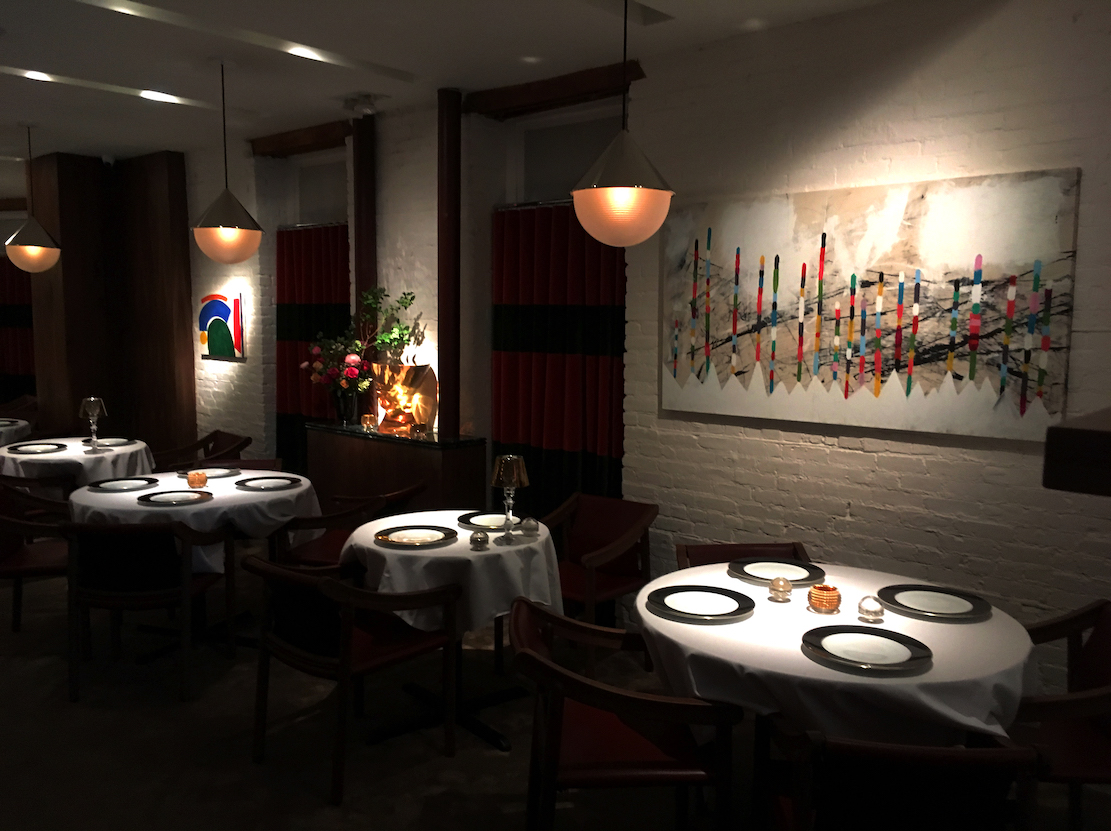
Despite media neglect, New York’s Upper West Side has more upscale dining restaurants than ever, including Boulud Sud, The Grand Tier, Lincoln Ristorante, Per Se, Masa, The Leopard at Café des Artistes and, opened last fall, Leonti, on the premises of what had been the fine dining restaurant Dovetail.
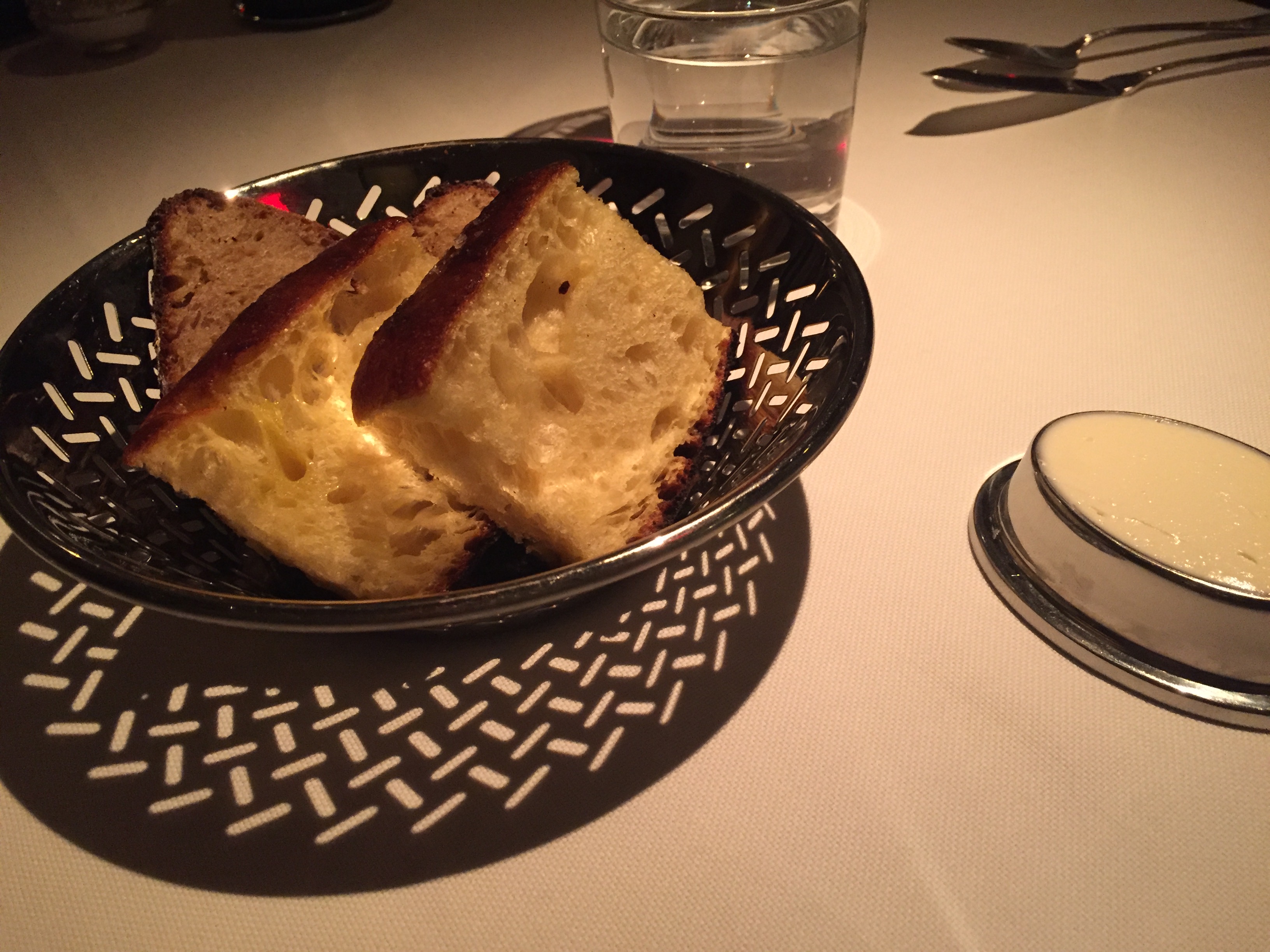 Leonti has achieved that
rare thing in New York
these days: Where Dovetail had been one of the
most egregiously loud
restaurants in the city, its acoustics have been
transformed so that Leonti is
a very civilized place for people to dine within a
room that might well be
exemplary of modern Milanese décor.
Leonti has achieved that
rare thing in New York
these days: Where Dovetail had been one of the
most egregiously loud
restaurants in the city, its acoustics have been
transformed so that Leonti is
a very civilized place for people to dine within a
room that might well be
exemplary of modern Milanese décor.
You walk up a few steps and the room opens up
to well-set tables amidst varnished wood columns
and soft-white brick walls,
with lights on the tables and ceiling chandeliers
that cast a subtle glow.
Chairs are exceptionally comfortable. Gold-rimmed china and silver domes are
part of the service, wineglasses
thin. The staff is in dark suits; the male
clientele mostly without. No booming
music intrudes and the well-trained, highly
professional staff moves with ease
in their courteous ministrations. The oddly varied
artwork could, however, be
better focused to maintain a theme of elegance. 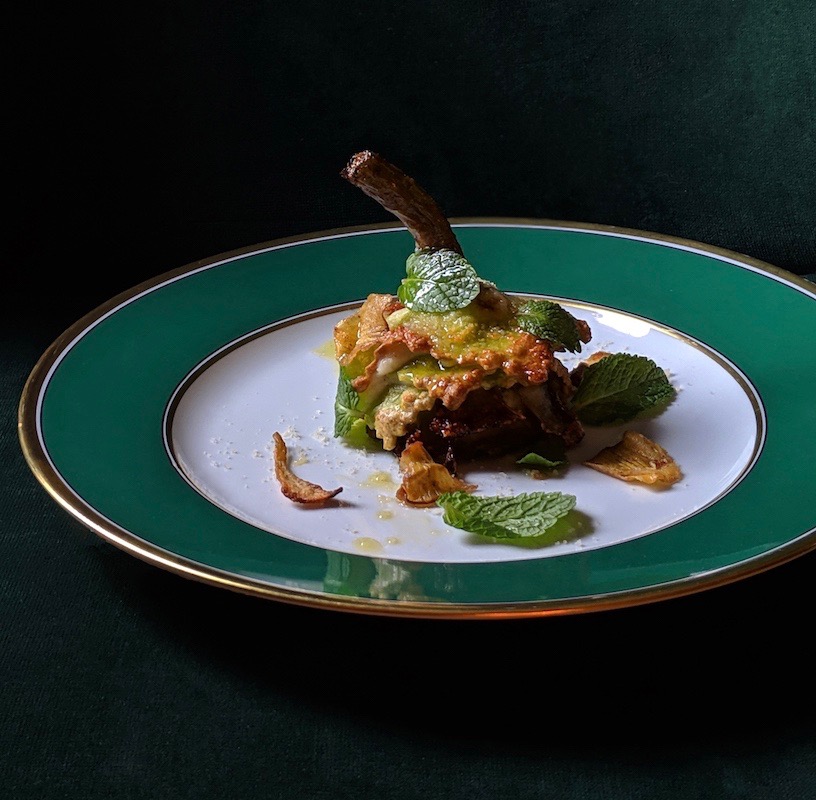
Adam Leonti, formerly chef de cuisine at Vetri Cucina in Philadelphia, is trying to carve out a highly personalized style on Italian food, and on my first visit some months ago, I found some of the dishes overly elaborated and clumsy. The menu has since calmed down a bit, though the high prices have not. Full, though not generous, portions of pastas at $24 to $38 are the equal of the prices at Ai Fiori, but higher than Sant Ambroeus, with main courses ranging from $32 to $42.
Indeed, generosity is hardly to be found at Leonti. An amuse consisted of one, single stuffed olive and a sip of beef broth. The breads are excellent, however—the focaccia extraordinary (above)—as is the big slab of butter brought to the table.
One of the best items on the menu since the beginning is a Roman-style artichoke green noodle lasagna richly embellished with a minted besciamella ($24); a similar treatment to a superbly sweet scallop (yes, just one) breaded and seasoned with oregano and lashed with a cheese-and-butter Alfredo sauce ($22).
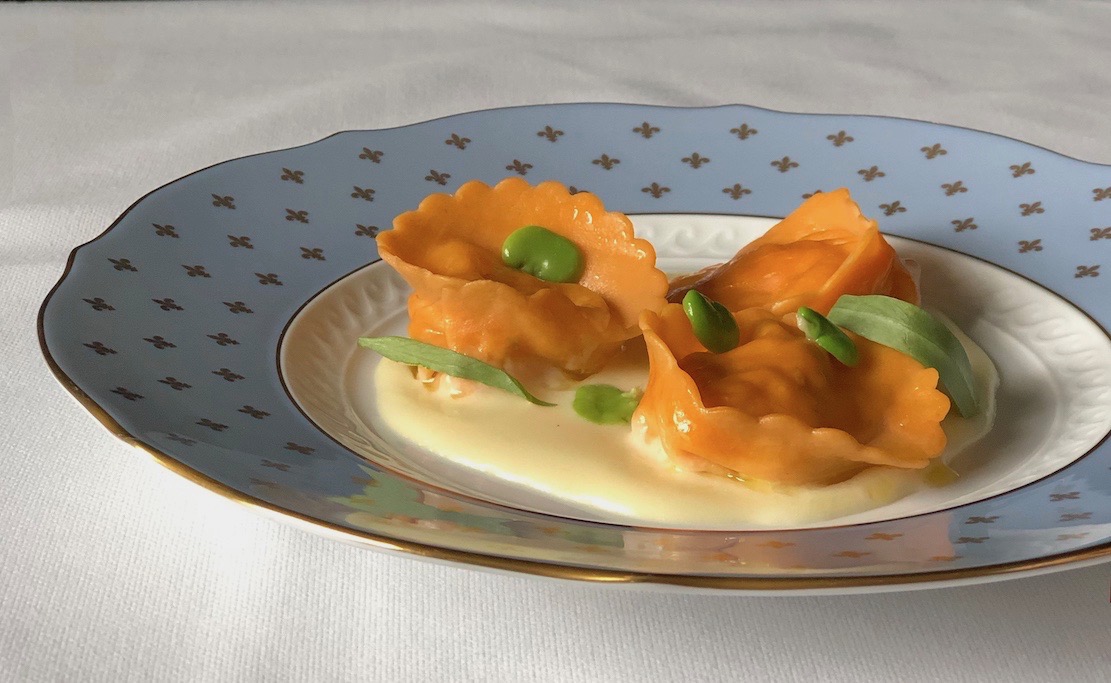 The best of the four
pastas on the menu is the
simplest: tagliatelle
(unfortunately
a tad gummy) with morels and Parmigiano ($28). Cappellacci stuffed
with
lamb in a pecorino fonduta
with
fava beans and tarragon is a pleasing dish, but
$29 for three of the pasta
packets is not. Very thin pappardelle stuffed
with
baccalà cod
was terrible, not
only because the amount of baccalà
was minimal but because it swam in a malodorous,
fishy sauce of clam broth,
shrimp, calamari and, adding to its strong taste,
uni ($38).
The best of the four
pastas on the menu is the
simplest: tagliatelle
(unfortunately
a tad gummy) with morels and Parmigiano ($28). Cappellacci stuffed
with
lamb in a pecorino fonduta
with
fava beans and tarragon is a pleasing dish, but
$29 for three of the pasta
packets is not. Very thin pappardelle stuffed
with
baccalà cod
was terrible, not
only because the amount of baccalà
was minimal but because it swam in a malodorous,
fishy sauce of clam broth,
shrimp, calamari and, adding to its strong taste,
uni ($38).
Main courses did not fare well. A whole,
salt-baked branzino was an impressive presentation
within its snowy mountain of
sea salt, with Savoy cabbage, crab involtini
and a lobster butter ($65), but, with an endless
amount of branzino in the
market, this one had very little flavor. And it
came tepid. 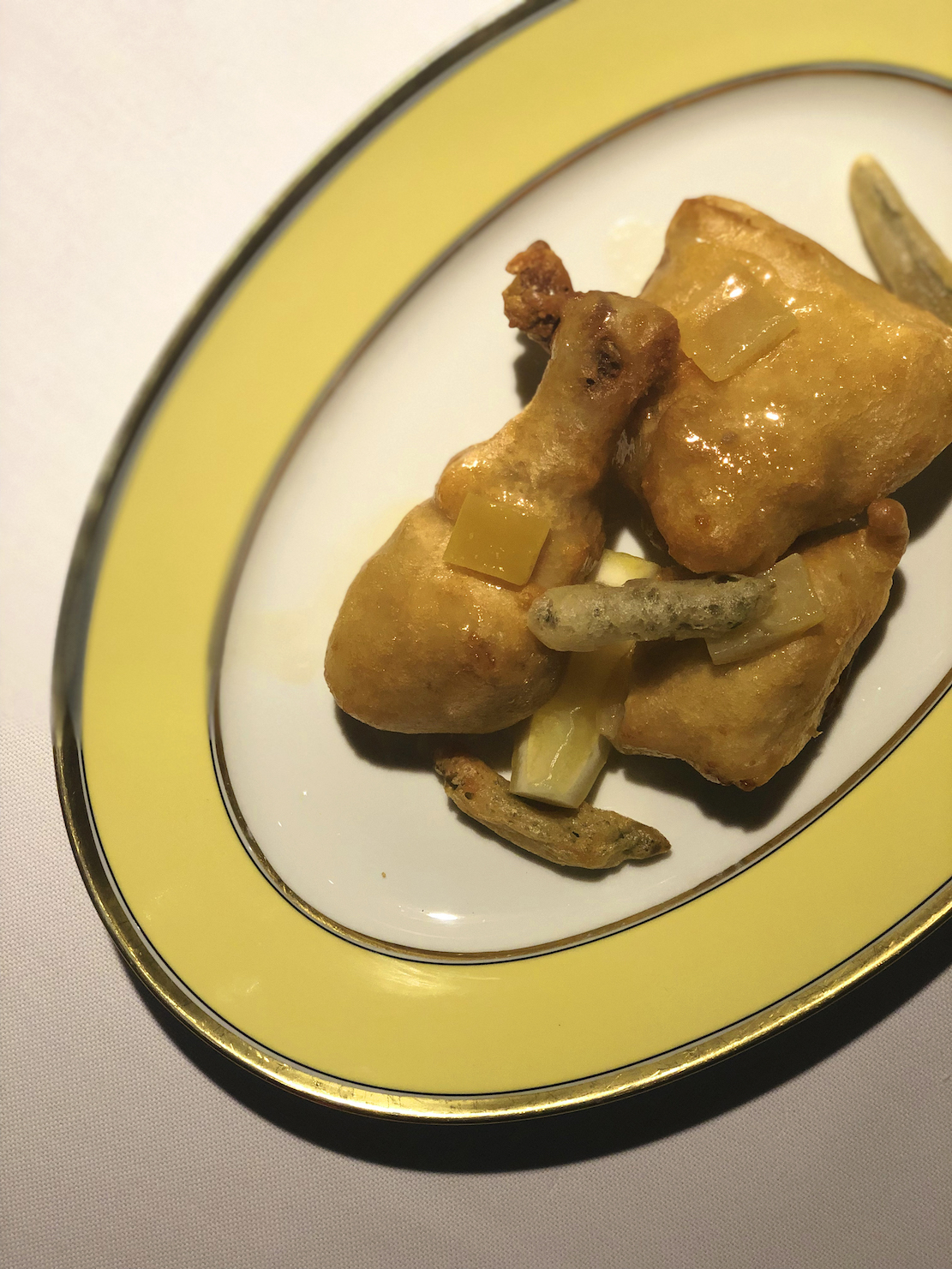
Stuffed rabbit with cipollini, pistachio and grappa-soaked carrots ($38) was an interesting dish, but so salty as to make one bite more than enough.
Apparently even Italian ristoranti must serve wagyu these days, and Leonti offers a tagliata cut of unknown origin—five slices of chewy, not particularly flavorful beef inelegantly placed on a plate with a few capers and a bland, cold cannellini bean puree on the side ($55).
Everyone at our table of five was puzzled when an unattractive portion of deep-fried chicken arrived ($36), whose very brittle, salty skin made from sourdough batter broke free of the poultry meat in shards, leaving the naked, lukewarm chicken behind. Why this is even on an Italian menu is beyond me.
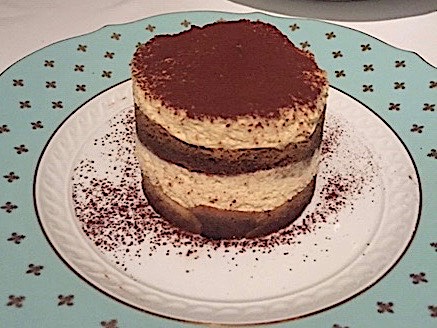 The desserts may not be
imaginative at Leonti
but they are well rendered, especially a
first-rate tiramisù.
The desserts may not be
imaginative at Leonti
but they are well rendered, especially a
first-rate tiramisù.
The wine stash, some purchased from Dovetail, is one of the richest, in both senses of the word, in town—impressive in its breadth and depth, with plenty of $500-plus bottles throughout but few under $100.
For its cosmopolitan ambiance Leonti is an easy place to enjoy, but for most Italian food-lovers it will have to be a rare indulgence at these prices. With more focus on ingredients and a more generous hand in the kitchen, Leonti could evolve into one of New York’s finest.
❖❖❖
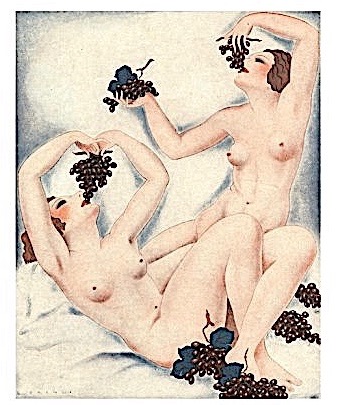 CELEBRATE
SUMMER’S ARRIVAL
CELEBRATE
SUMMER’S ARRIVAL WITH THESE WONDERFUL WINES
Summer has officially begun, offering ample opportunities to try out some well-priced wines for those outdoor parties when not everyone appreciates the high-priced wines. Here are several I’m happy to drink through August.
DOMAINE
WEINBACH PINOT GRIS 2017 ($33)—As
an aperitif, with just a slight sweetness,
this Alsatian Pinot Gris (Pinot Grigio in
Italy) has delightful levels of
flavor and citrus. With just about any
canapé, cheese or tapas, this is a great
way to begin the afternoon.
HORTON VINEYARDS PETIT MANSENG 2016 ($25)—A gold medal winner this spring at the Virginia Governor’s Cup competition, this Petite Manseng (a popular grape in southwestern France) has plenty of floral notes along with nut flavors and a good deal of tropical fruit buoying it all up. Very good match with shellfish.
MACROSTIE SONOMA COAST CHARDONNAY 2017 ($25)—This is the price level at which American Chardonnays begin to show off their distinctive character, and founder Steve MacRostie has been refining his for forty years now. Made from a blend of grapes from Russian River Valley and the Sonoma Coast, it has just enough oak to bring out the vanilla without being a cloying example. It is creamy but refreshing and a very good match for whole fish on the grill.
FRANCIS COPPOLA RESERVE CHARDONNAY 2015 ($41)—I’m not a fan of several Coppola wines, but this one deserves its price for a Chardonnay smack in the zone for those who like them big, fruity and able to stand up to garlic, as with spaghetti with clam sauce. It pushes the alcohol level that can wreck a Chardonnay, but drink it now and be amazed at its finesse.
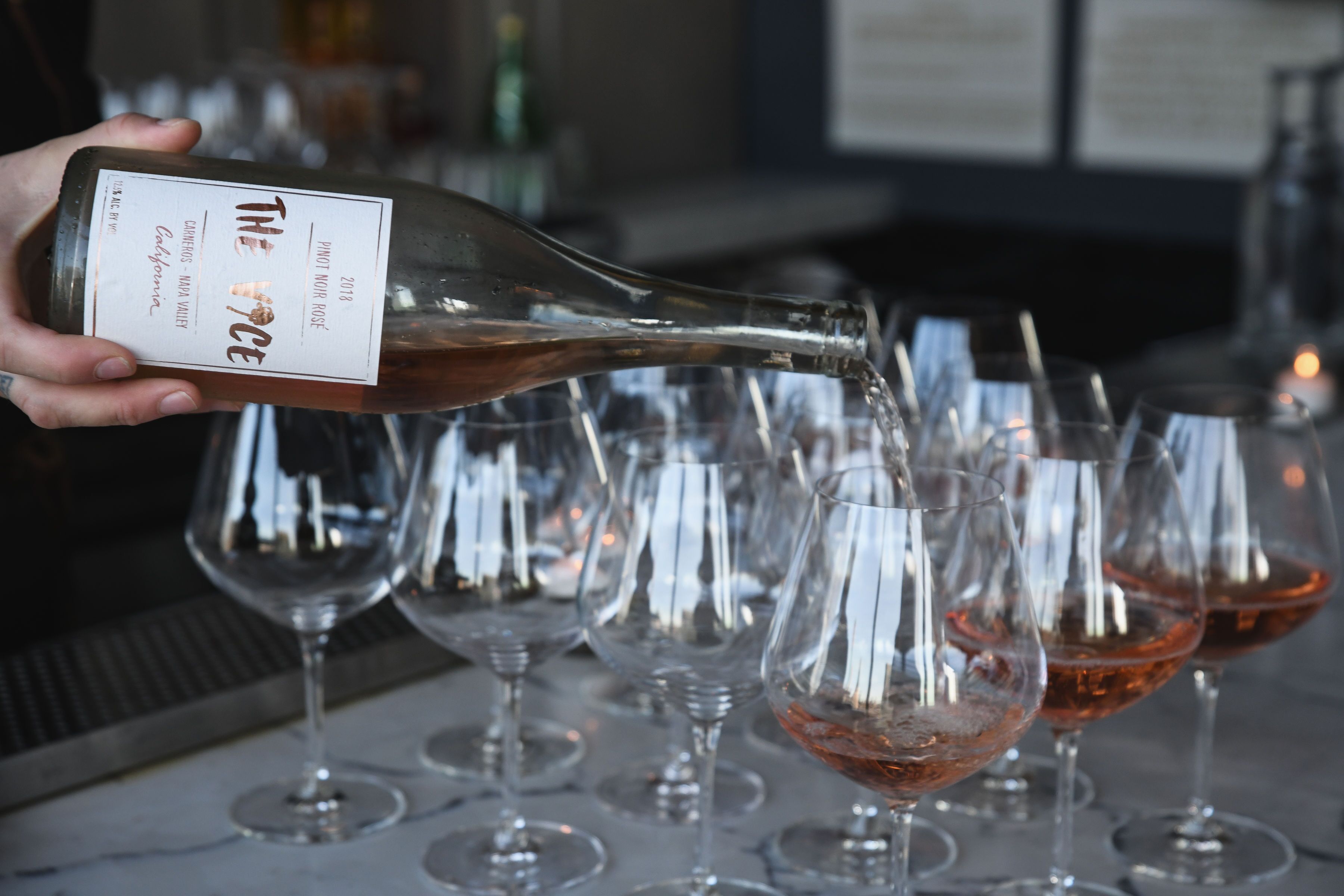 CHÂTEAU
GRAND
TAYAC 2014 ($30)—A remarkable
price for a basic Margaux, made from 70%
Cabernet Sauvignon, 27% Merlot and 3% Petit
Verdot (no Cabernet Franc),
with that Merlot really smoothing down the
tannins into a soft, velvety,
fruit-forward red wine that will serve all
summer long with anything from
chicken to sirloins. Try it with salmon,
too.
CHÂTEAU
GRAND
TAYAC 2014 ($30)—A remarkable
price for a basic Margaux, made from 70%
Cabernet Sauvignon, 27% Merlot and 3% Petit
Verdot (no Cabernet Franc),
with that Merlot really smoothing down the
tannins into a soft, velvety,
fruit-forward red wine that will serve all
summer long with anything from
chicken to sirloins. Try it with salmon,
too.
THE VICE PINOT NOIR BATCH #10 ROSÉ 2018 ($23)—Pinot Noir almost always makes for a more interesting rosé in the hands of a good winemaker, and this Carneros Napa Valley example has plenty of fruit and flowers, with just 12% alcohol. The vintage was, according to founder and owner Malek Amrani, “A winemaker’s dream,” with above average yields. A fine choice to go with summer cheeses, sausage and pastas.
❖❖❖
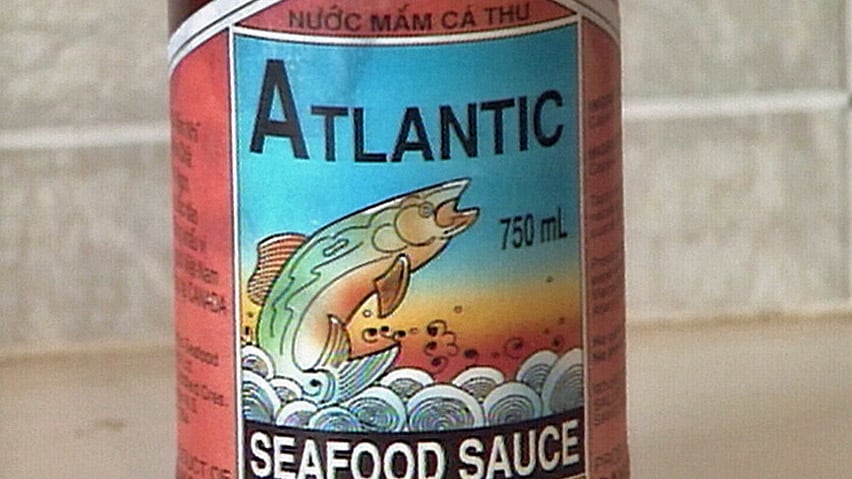 MAYBE IF
THEY HOSE IT DOWN WITH SOY SAUCE?
MAYBE IF
THEY HOSE IT DOWN WITH SOY SAUCE?
"On a good day the
wind blows the fumes right out to sea, but the
residents of St. Mary’s, Newfoundland aren’t
always that lucky. When the wind comes from the
northeast, it carries the stench of over 100 vats
of rotten, nearly 20-year-old fish sauce into the
homes and business of everyone in the tiny
community. The reason: the hollowed-out shell of
what was once the Atlantic Seafood Sauce Company,
which closed its doors in 2001."--Madeline Muzzi,
"A Town Drowned in the Smell of
Fish Sauce: What will it take to clean up
Newfoundland’s abandoned fish sauce
factory?" Eater.com
(5/23/19)
IT'S
A COMPLETE, NUTRITIOUS MEAL!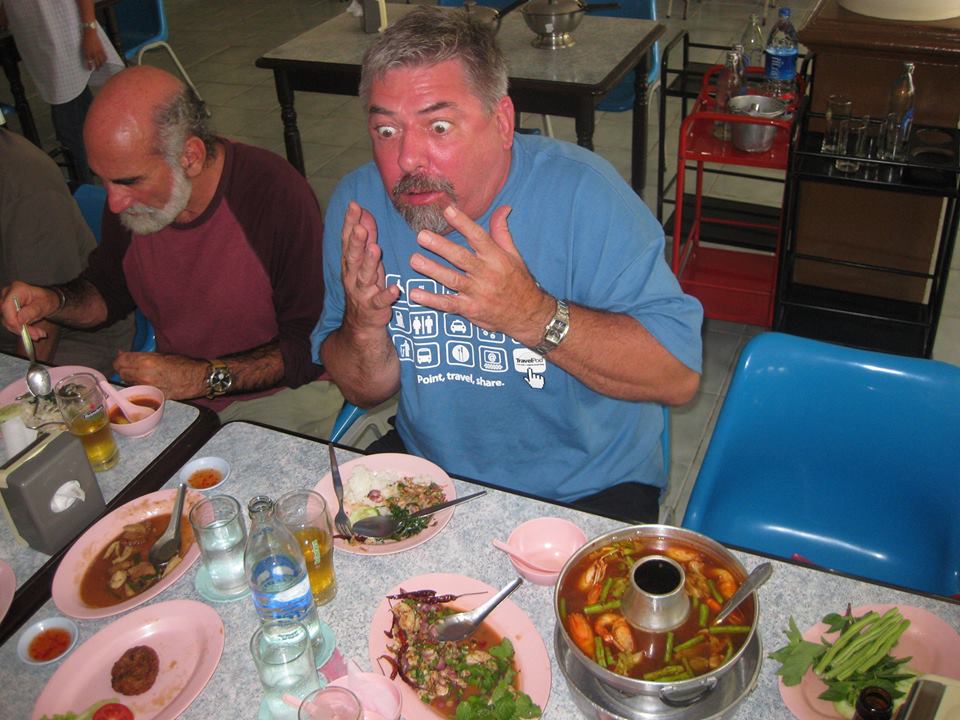
The U.S.
Agriculture Department is proposing that canned, spray-able cheese like Cheez
Whiz should be listed as a “staple” under the food stamp
program, along with beef jerky and pimiento-stuffed
olives.
Wine
Column Sponsored by Banfi Vintners
SANGIOVESE
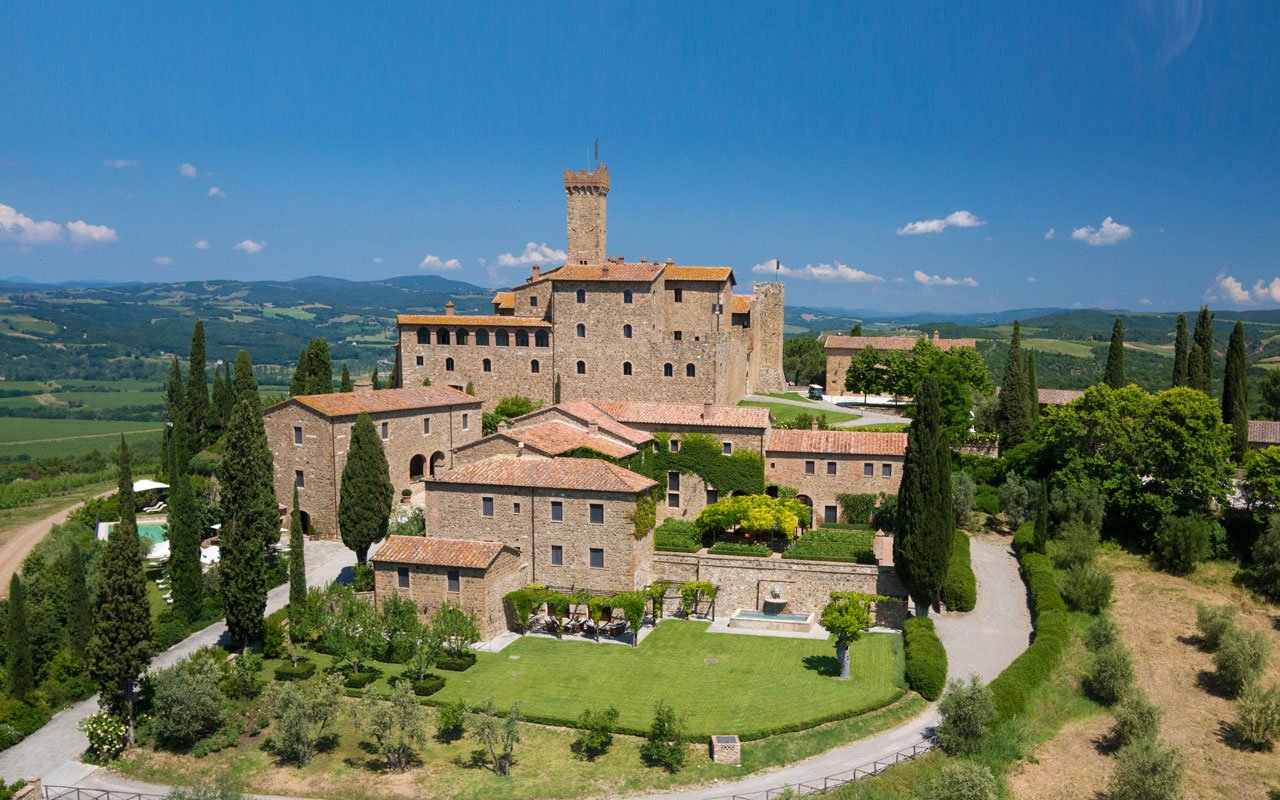 Wine is a joy year-round but
in cooler weather one
grape varietal has really taken center stage in
my daily activities – that most Italian of
grapes, Sangiovese, and its ultimate expression
– Brunello di Montalcino.
Wine is a joy year-round but
in cooler weather one
grape varietal has really taken center stage in
my daily activities – that most Italian of
grapes, Sangiovese, and its ultimate expression
– Brunello di Montalcino.
From mid-September through mid-October,
the Sangiovese grown for our various styles of red
wines are be harvested, culminating with the top
selection for Brunello di Montalcino.
Second, cooler weather here means
it is time to start enjoying more red wines and
especially Sangiovese based wines. That
includes Banfi’s cru of Brunello, Poggio alle Mura,
literally the cream of the crop of our Sangiovese
vineyards. Alongside our Poggio alle Mura Brunello di
Montalcino, this year we introduced two more wines
from the cru Poggio alle Mura – a Rosso di Montalcino
and a Riserva of Brunello. Rosso is sort of like the
younger brother of Brunello, also made from 100%
Sangiovese grapes but usually a selection from younger
vines and the wine is aged only two years compared to
the four required for Brunello. The
Riserva, on the other hand, is an even more selective
harvest of Sangiovese, and ages for an additional year
before release.
What is so special about this cru
Poggio alle Mura?
Well, it is the result our over 30 years of
ongoing research at my family’s vineyard estate,
Castello Banfi.
When we first began planting our vines there in
the late 1970s studies from the University of Bordeaux
indicated which strains of many varietals we should
plant, based on the soil type and microclimate of each
vineyard. But
when it came to the region’s native Sangiovese, there
was only local lore, no scientific research. So we took
it upon ourselves to figure out this vine, and set off
on three decades of incredibly detailed research.
We started
with 600 apparent variations on Sangiovese, because it
is so susceptible to variations in weather and soil,
and narrowed that down to 160 truly genetically
different clones.
We planted a vineyard with two rows of each
type, made wine from each of them, and charted the
differences – remember, you only get one chance a year
to make wine, so this took time.
It took about ten years to get some
concrete results, though we continue to experiment
today and always will – you never stop learning in
science and nature!
Once we determined which were the best,
complementary clones that could be planted together to
make the best Brunello, we chose to plant them in what
we determined to be the optimal vineyard sites. Coincidentally,
the best soils and climate conditions are in the
slopes surrounding the medieval fortress today known
as Castello Banfi, known since Etruscan times as
Poggio alle Mura – the walled hilltop. Hence the
name of our most special “cru” of Brunello,
representing a synthesis between tradition and
innovation.
Though the focus of this study was
our Brunello, all of our Sangiovese-based wines,
including the super Tuscans SummuS, Cum Laude, and
Centine, benefitted from this work. And that’s
the third reason for celebrating Sangiovese this
month, for the range of wonderful reds that usher us
into autumn! One
wine in particular was inspired by our research – the
BelnerO, a Sangiovese dominant blend with what I like
to call a kiss of Cabernet and a whisper of Merlot. We grow the
grapes a little differently for BelnerO than for
Brunello, make the wine with less oak aging and
released it earlier from the winery, providing a
counterpoint to Brunello and a lovely terroir-driven
wine in its own right.
If you
know Italians, you know that by nature we are
multi-faceted, varying in mood, and always passionate. As a
nation, we span from the hot sunny beaches of Sicily
near the African coast to the rugged mountains and
Alpine ski slopes of Trentino-Alto Adige in the north. Sangiovese
is grown in almost all of Italy’s regions and reflects
the unique nature of each; it is most famous
(rightfully so) in Tuscany, yet even there it reflects
the nuances of each hilltop, valley and subzone. It has
something a little different to say in Brunello than
Chianti, Morellino than Vino Nobile di Montepulciano,
Rosso di Montalcino than Super Tuscan blends.
Here is a smattering of
Sangiovese-based wines that you may wish to get to
know better, reflecting a spectrum that appeals to
every occasion, every taste, and every budget. We can
assure you that the conversation will never become
boring. 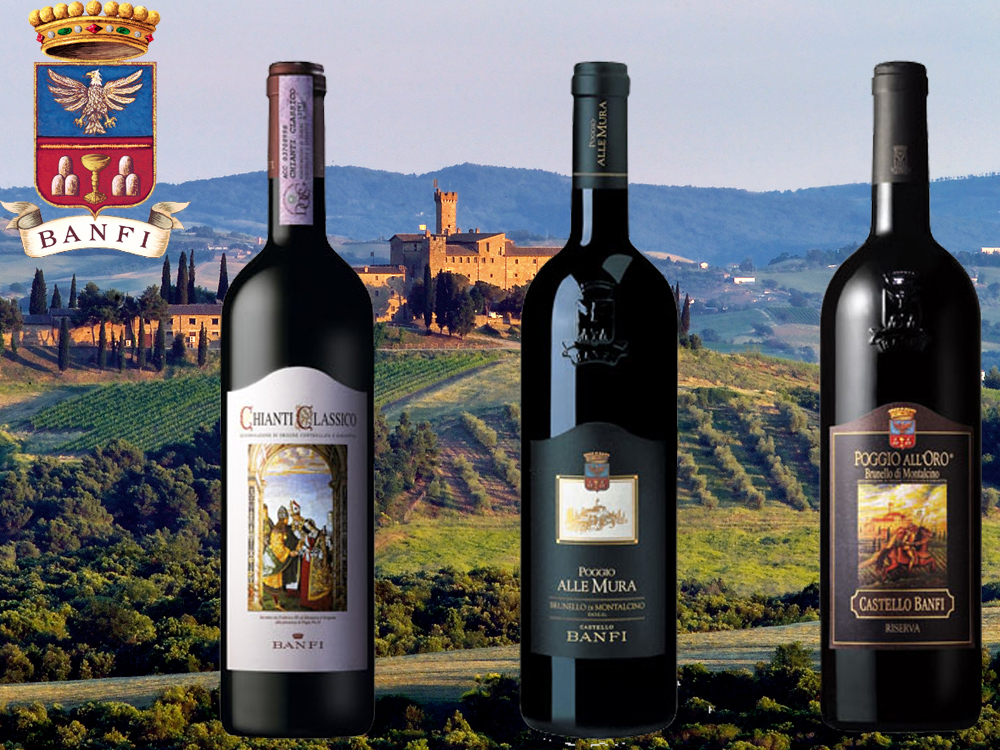
Recommendations for Celebrating
Sangiovese
BelnerO Proprietor’s Reserve Sangiovese
– A refined
cuvée of noble red grapes perfected by our pioneering
clonal research. This dark beauty, BelnerO, is
produced at our innovative winery, chosen 11
consecutive years as Italy’s Premier Vineyard Estate.
Fermented in our patented temperature controlled
French oak and aged approximately 2 additional years.
Unfiltered, and Nitrogen bottled to minimize sulfites.
Castello Banfi Brunello di Montalcino –
Rich, round, velvety and intensely
aromatic, with flavor hints of licorice, cherry, and
spices. Brunello di Montalcino possesses an intense
ruby-red color, and a depth, complexity and opulence
that is softened by an elegant, lingering aftertaste.
Unfiltered after 1998 vintage.
Castello Banfi Rosso di Montalcino – Brunello's "younger brother," produced
from select Sangiovese grapes and aged in barrique for
10 to 12 months. Deep ruby-red, elegant, vibrant,
well-balanced and stylish with a dry velvety
finish.
Poggio all’Oro Brunello di Montalcino
Riserva – A single vineyard selection of our most
historically outstanding Sangiovese, aged five years
before release, the additional year more than that
required of Brunello including 6 months in barrel and
6 months more in bottle to grant its “Riserva”
designation. Incredible
elegance and harmony. Intense with lots of fruit and
subtle wood influence. Round, complete, well balanced
with hints of chocolate and berries. Unfiltered after
1998.
Poggio alle Mura – The first tangible result of years of
intensive clonal research on Montalcino’s native
Sangiovese grape.
Estate bottled from the splendidly sun drenched
vineyards surrounding the medieval Castello from which
it takes its name.
The Brunello
di Montalcino is seductive, silky and smoky. Deep ruby
in color with an expressive bouquet of violets, fruits
and berries as well as cigar box, cedar and exotic
spices. The Rosso
di Montalcino is also intense ruby red. The bouquet
is fresh and fruity with typical varietal notes of
cherry and blackberry, enriched by more complex hints
of licorice, tobacco and hazelnut. It is full
bodied, yet with a soft structure, and a surprisingly
long finish. The Poggio alle Mura Brunello di Montalcino
Riserva is deep ruby red with garnet
reflections and a rich, ample bouquet that hints of
prune jam, coffee, cacao and a light balsamic note. It is full
and powerful, with ripe and gentle tannins that make
it velvety and harmonious; this wine is supported by a
pleasing minerality that to me speaks soundly of that
special hillside in southern Montalcino.
SummuS – A wine of towering elegance, SummuS is an
extraordinary blend of Sangiovese which contributes
body; Cabernet Sauvignon for fruit and structure; and
Syrah for elegance, character and a fruity bouquet. An elegant,
complex and harmonious red wine.
Cum Laude – A complex and elegant red which graduated
“With Honors,” characterized by aromas of juicy
berries and fresh spices.
Centine – A Cuvee that is more than half
Sangiovese, the balanced consisting of equal parts of
Cabernet Sauvignon and Merlot. Vinified in
a firm, round style that easily accompanies a wide
range of dishes, this is a smooth and fragrantly
satisfying wine with international character, and a
perennial favorite at my own dinner table.
Banfi Chianti Superiore – The “Superiore” designation signifies
stricter government regulations regarding production
and aging requirements, as compared to regular
Chianti. An
intense ruby red wine with fruit forward aromas and
floral notes. This
is a round wine with well-balanced acidity and fruit.
Banfi Chianti Classico – An enduring classic: alluring
bouquet of black fruit and violets; rich flavors of
cherry and leather; supple tannins and good acidity
for dining.
Banfi Chianti Classico Riserva – Produced from select grapes grown in the
"Classico" region of Chianti, this dry, fruity and
well-balanced red has a full bouquet reminiscent of
violets.
Fonte alla Selva Chianti Classico – This is our newest entry into the Chianti
arena, coming from a 99 acre estate in Castellina, the
heart of the Chianti Classico region. The wine is
a captivating mauve red that smells of cherry, plum
and blackberry with hints of spice. It is
round, full and balanced with very good
acidity.
Col di Sasso – Sangiovese and Cabernet Sauvignon. Luscious,
complex and soft with persistent notes of fruit and
great Italian style structure.
Any of John Mariani's books below may be ordered from amazon.com.
 The Hound in Heaven
(21st Century Lion Books) is a novella, and
for anyone who loves dogs, Christmas, romance,
inspiration, even the supernatural, I hope you'll find
this to be a treasured favorite. The story
concerns how, after a New England teacher, his wife and
their two daughters adopt a stray puppy found in their
barn in northern Maine, their lives seem full of promise.
But when tragedy strikes, their wonderful dog Lazarus and
the spirit of Christmas are the only things that may bring
his master back from the edge of despair.
The Hound in Heaven
(21st Century Lion Books) is a novella, and
for anyone who loves dogs, Christmas, romance,
inspiration, even the supernatural, I hope you'll find
this to be a treasured favorite. The story
concerns how, after a New England teacher, his wife and
their two daughters adopt a stray puppy found in their
barn in northern Maine, their lives seem full of promise.
But when tragedy strikes, their wonderful dog Lazarus and
the spirit of Christmas are the only things that may bring
his master back from the edge of despair. WATCH THE VIDEO!
“What a huge surprise turn this story took! I was completely stunned! I truly enjoyed this book and its message.” – Actress Ali MacGraw
“He had me at Page One. The amount of heart, human insight, soul searching, and deft literary strength that John Mariani pours into this airtight novella is vertigo-inducing. Perhaps ‘wow’ would be the best comment.” – James Dalessandro, author of Bohemian Heart and 1906.
“John Mariani’s Hound in Heaven starts with a well-painted portrayal of an American family, along with the requisite dog. A surprise event flips the action of the novel and captures us for a voyage leading to a hopeful and heart-warming message. A page turning, one sitting read, it’s the perfect antidote for the winter and promotion of holiday celebration.” – Ann Pearlman, author of The Christmas Cookie Club and A Gift for my Sister.
“John Mariani’s concise, achingly beautiful novella pulls a literary rabbit out of a hat – a mash-up of the cosmic and the intimate, the tragic and the heart-warming – a Christmas tale for all ages, and all faiths. Read it to your children, read it to yourself… but read it. Early and often. Highly recommended.” – Jay Bonansinga, New York Times bestselling author of Pinkerton’s War, The Sinking of The Eastland, and The Walking Dead: The Road To Woodbury.
“Amazing things happen when you open your heart to an animal. The Hound in Heaven delivers a powerful story of healing that is forged in the spiritual relationship between a man and his best friend. The book brings a message of hope that can enrich our images of family, love, and loss.” – Dr. Barbara Royal, author of The Royal Treatment.
 |
The Encyclopedia of American Food and Drink by John F. Mariani (Bloomsbury USA, $35) Modesty forbids me to praise my own new book, but let me proudly say that it is an extensive revision of the 4th edition that appeared more than a decade ago, before locavores, molecular cuisine, modernist cuisine, the Food Network and so much more, now included. Word origins have been completely updated, as have per capita consumption and production stats. Most important, for the first time since publication in the 1980s, the book includes more than 100 biographies of Americans who have changed the way we cook, eat and drink -- from Fannie Farmer and Julia Child to Robert Mondavi and Thomas Keller. "This book is amazing! It has entries for everything from `abalone' to `zwieback,' plus more than 500 recipes for classic American dishes and drinks."--Devra First, The Boston Globe. "Much needed in any kitchen library."--Bon Appetit. |
"Eating Italian will never be the same after reading John Mariani's entertaining and savory gastronomical history of the cuisine of Italy and how it won over appetites worldwide. . . . This book is such a tasteful narrative that it will literally make you hungry for Italian food and arouse your appetite for gastronomical history."--Don Oldenburg, USA Today. "Italian
restaurants--some good, some glitzy--far
outnumber their French rivals. Many of
these establishments are zestfully described
in How Italian Food Conquered the World, an
entertaining and fact-filled chronicle by
food-and-wine correspondent John F.
Mariani."--Aram Bakshian Jr., Wall Street
Journal.
"Equal parts
history, sociology, gastronomy, and just
plain fun, How Italian Food Conquered the
World tells the captivating and delicious
story of the (let's face it) everybody's
favorite cuisine with clarity, verve and
more than one surprise."--Colman Andrews,
editorial director of The Daily
Meal.com. "A fantastic and fascinating
read, covering everything from the influence
of Venice's spice trade to the impact of
Italian immigrants in America and the
evolution of alta cucina. This book will
serve as a terrific resource to anyone
interested in the real story of Italian
food."--Mary Ann Esposito, host of PBS-TV's
Ciao
Italia. "John Mariani has written the
definitive history of how Italians won their
way into our hearts, minds, and
stomachs. It's a story of pleasure over
pomp and taste over technique."--Danny Meyer,
owner of NYC restaurants Union Square
Cafe, The Modern, and Maialino.
|
 |
 |
 |
 |
 |
 |
 |
 |
 Everett Potter's Travel Report:
Everett Potter's Travel Report: 
 Eating Las Vegas
JOHN CURTAS has been covering the Las Vegas
food and restaurant scene since 1995. He is
the co-author of EATING LAS VEGAS – The 50
Essential Restaurants (as well as
the author of the Eating Las Vegas web site: www.eatinglasvegas.
He can also be seen every Friday morning as
the “resident foodie” for Wake Up With the
Wagners on KSNV TV (NBC) Channel 3 in
Las Vegas.
Eating Las Vegas
JOHN CURTAS has been covering the Las Vegas
food and restaurant scene since 1995. He is
the co-author of EATING LAS VEGAS – The 50
Essential Restaurants (as well as
the author of the Eating Las Vegas web site: www.eatinglasvegas.
He can also be seen every Friday morning as
the “resident foodie” for Wake Up With the
Wagners on KSNV TV (NBC) Channel 3 in
Las Vegas.
MARIANI'S VIRTUAL GOURMET
NEWSLETTER is published weekly. Publisher: John Mariani. Editor: Walter Bagley. Contributing Writers: Christopher Mariani,
Robert Mariani, Misha Mariani, John A. Curtas, Gerry Dawes, Geoff Kalish,
and Brian Freedman. Contributing
Photographer: Galina Dargery. Technical
Advisor: Gerry
McLoughlin.
If you wish to subscribe to this
newsletter, please click here: http://www.johnmariani.com/subscribe/index.html
© copyright John Mariani 2019

